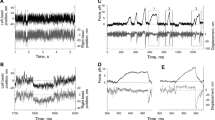Abstract
The myosin cross-bridge has two essential properties: to undergo the “power stroke” and to bind and release from actin – both under control of ATP binding and hydrolysis. In the absence of ATP the cross-bridge binds to actin with high affinity: the binding of ATP causes rapid release of the cross-bridge from actin. The actin binding-site is split by a deep cleft that closes on strong binding to actin. The cleft is straddled by a short polypeptide known as the “strut”. In the following we summarise the structural basis of the power stroke and the control of actin affinity and then present data on the effects on actin affinity of replacing the strut by a flexible linker.
Similar content being viewed by others
References
Batra R, Geeves MA, Manstein DJ, (1999) Kinetic analysis of Dictyostelium discoideum myosin motor domains with glycine-to-alanine mutations in the reactive thiol region Biochemistry 38: 6126–6134
Batra R, Manstein DJ, (1999) Functional characterisation of Dictyostelium myosin II with conserved tryptophanyl residue 501 mutated to tyrosine Biol Chem 380: 1017–1023
Coureux PD, Sweeney HL, Houdusse A, (2004) Three myosin V structures delineate essential features of chemo-mechanical transduction Embo J 23: 4527–4537
Coureux PD, Wells AL, Menetrey J, Yengo CM, Morris CA, Sweeney HL, Houdusse A, (2003) A structural state of the myosin V motor without bound nucleotide Nature 425: 419–423
Esnouf RM (1997) An extensively modified version of MolScript that includes greatly enhanced coloring capabilities. J Mol Graph Model 15: 132–134, 112–113
Esnouf RM, (1999) Further additions to MolScript version 1.4, including reading and contouring of electron-density maps Acta Crystallogr D Biol Crystallogr 55: 938–940
Geeves M and Holmes K (2005) The molecular mechanism of muscle contraction. Adv Protein Chem 79:161–193
Geeves MA (1992) The actomyosin ATPase: a two-state system. Philos Trans R Soc Lond B Biol Sci 336: 63–70; discussion 70–71
Gulick AM, Bauer CB, Thoden JB, Rayment I, (1997) X-ray structures of the MgADP, MgATPgammaS, and MgAMPPNP complexes of the Dictyostelium discoideum myosin motor domain Biochemistry 36: 11619–11628
Holmes KC, Angert I, Kull FJ, Jahn W, Schroder RR, (2003) Electron cryo-microscopy shows how strong binding of myosin to actin releases nucleotide Nature 425: 423–427
Holmes KC, Schroder RR, Sweeney HL, Houdusse A, (2004) The structure of the rigor complex and its implications for the power stroke Philos Trans R Soc Lond B Biol Sci 359: 1819–1828
Kraulis PJ, (1991) MOLSCRIPT: a program to produce both detailed and schematic plots of proteins structures J Appl Cryst 24: 946–950
Kurzawa-Goertz SE, Perreault-Micale CL, Trybus KM, Szent-Gyorgyi AG, Geeves MA, (1998) Loop I can modulate ADP affinity, ATPase activity, and motility of different scallop myosins. Transient kinetic analysis of S1 isoforms Biochemistry 37: 7517–7525
Lymn RW, Taylor EW, (1971) Mechanism of adenosine triphosphate hydrolysis by actomyosin Biochemistry 10: 4617–4624
Margossian SS, Lowey S, (1982) Preparation of myosin and its subfragments from rabbit skeletal muscle Methods Enzymol 85: 55–71
Merritt EA, Bacon DJ, (1997) Raster3D Version 2: photorealistic molecular graphics Methods Enzymol 277: 505–524
Millar NC, Geeves MA, (1983) The limiting rate of the ATP-mediated dissociation of actin from rabbit skeletal muscle myosin subfragment 1 FEBS Lett 160: 141–148
Nagi AD, Anderson KS, Regan L, (1999) Using loop length variants to dissect the folding pathway of a four-helix-bundle protein J Mol Biol 286: 257–265
Rayment I, Rypniewski WR, Schmidt-Base K, Smith R, Tomchick DR, Benning MM, Winkelmann DA, Wesenberg G, Holden HM, (1993) Three-dimensional structure of myosin subfragment-1: a molecular motor Science 261: 50–58
Reubold TF, Eschenburg S, Becker A, Kull FJ, Manstein DJ, (2003) A structural model for actin-induced nucleotide release in myosin Nat Struct Biol 10: 826–830
Sasaki N, Ohkura R, Sutoh K, (2000) Insertion or deletion of a single residue in the strut sequence of Dictyostelium myosin II abolishes strong binding to actin J Biol Chem 275: 38705–38709
Siemankowski RF, White HD, (1984) Kinetics of the interaction between actin, ADP, and cardiac myosin-S1 J Biol Chem 259: 5045–5053
Spudich JA, (1994) How molecular motors work Nature 372: 515–518
Smith CA, Rayment I, (1996) X-ray structure of the magnesium(II).adp.vanadate complex of the Dictyostelium discoideum myosin motor domain to 1.9 Å resolution Biochemistry 35: 5404–5417
Sweeney HL, Rosenfeld SS, Brown F, Faust L, Smith J, Xing J, Stein LA, Sellers JR, (1998) Kinetic tuning of myosin via a flexible loop adjacent to the nucleotide binding pocket J Biol Chem 273: 6262–6270
Sweeney HL, Houdusse A, (2004) The motor mechanism of myosin V: insights for muscle contraction Philos Trans R Soc Lond B Biol Sci 359: 1829–1841
Vetter IR, Wittinghofer A, (2001) The guanine nucleotide-binding switch in three dimensions Science 294: 1299–1304
Acknowledgements
We are grateful to Prof D. Manstein and to Prof M. Geeves for helpful discussions. This work was supported by the Grant HO 481/16-1 from the Deutsche Forschungsgemeinschaft as part of the Schwerpunktprogram “Molecular Motors”. T.F.R. gratefully acknowledges support by a Peter und Traudl Engelhorn Stiftung postdoctoral fellowship. The following programs have been used in preparing the figures: BobScript v2.6 (Esnouf, 1997, 1999); Molscript (Kraulis, 1991); Raster 3D (Merritt and Bacon, 1997).
Author information
Authors and Affiliations
Corresponding author
Rights and permissions
About this article
Cite this article
FUJITA-BECKER, S., REUBOLD, T.F. & HOLMES, K.C. The actin-binding cleft: functional characterisation of myosin II with a strut mutation. J Muscle Res Cell Motil 27, 115–123 (2006). https://doi.org/10.1007/s10974-005-9047-0
Received:
Accepted:
Published:
Issue Date:
DOI: https://doi.org/10.1007/s10974-005-9047-0




